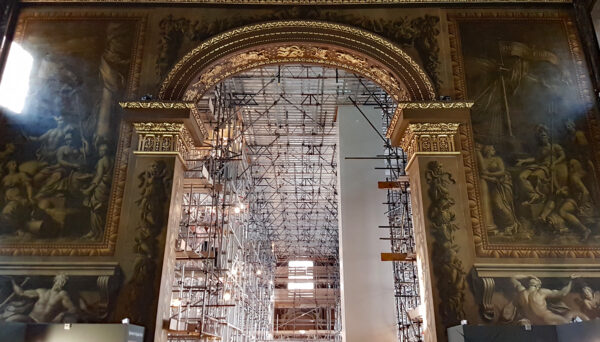After two years of being hidden from view under mountains of scaffolding, Greenwich’s magnificent Painted Hall is to reopen to the public in March. The Painted Hall has been referred to as the ‘Sistine Chapel of the UK’ and its decorated interior, extending to 4,000 square metres, is the masterpiece of English baroque art.
Over the past couple of years, a £8.5 million conservation project, supported by a £3.1-million grant from the Heritage Lottery Fund (HLF), has reversed decades of decay and conserved the Painted Hall for generations to come.
However, what was once a free building for everyone to wander into, will reopen with a £12 entry fee for adults.
The Painted Hall is the centrepiece of the Old Royal Naval College, Greenwich. Designed by Sir Christopher Wren as a ceremonial dining room for what was then the new Royal Hospital for Seaman, the Painted Hall was completed in 1705. Its vast decorative scheme was painted by Sir James Thornhill, the first British artist to be knighted. Started in 1707, it took 19 years to complete. The paintings celebrate England’s naval power and mercantile prosperity, as well as its newly installed protestant monarchy. Successive monarchs William III and Mary II, Anne and George I join a cast of hundreds of figures, mythological, allegorical, historical and contemporary.
The scheme’s celebration of the English protestant monarchy was set against the perceived autocracy of predominantly Catholic Europe. The main section of the ceiling (the Lower Hall) features William III taking an olive branch from a figure representing peace and passing the ‘cap of liberty’ to the kneeling figure of Europe. At the same time the king tramples on a crouched figure representing arbitrary power and tyranny – a thinly veiled portrait of Louis XIV of France.
The late 17th and early 18th centuries were a time of great uncertainty in Europe, with competing powers sparring for control of the continent and grand alliances made between nations to prevent dominance by any one European state. The story presented in the Painted Hall is one of stability and prosperity in Britain, underpinned by the nation’s naval power and benign constitutional rule. The other section of the ceiling (the Upper Hall) honours Queen Anne whose reign oversaw the unification of Great Britain.
The ground-breaking project to clean and conserve the paintings started in 2016 under the supervision of specialist conservators Stephen Paine and Sophie Stewart.
Since the last restoration in the 1950s the paintings have deteriorated, with large areas of ‘blanching’ or whitening covering the surface and obscuring the detail. As many as 30 signatures from previous ‘restorers’ were studied at close quarters, including one indelicately placed on the bosom of Mary II, revealing 300 years of almost continuous cleaning. For two years, a small team of conservators have been working to stabilise and rejuvenate the paintings, with spectacular results. The colour, clarity and richness of the paintings can now be enjoyed, illuminated by a new lighting system.
Meanwhile a range of new technologies have been introduced to stabilise the Hall’s environment and ensure the long term preservation of the paintings.
In addition, the King William Undercroft, a grandly proportioned vaulted space – mirroring the plan of the Painted Hall above and designed by Christopher Wren and his Clerk of Works, Nicholas Hawksmoor – has been restored to its original form.
20th-century additions, including part of a large modern kitchen, have been removed to reveal the space and the baroque architectural details. This space, originally used as a day-to-day dining room for the naval pensioners, will now house a shop, café and The Sackler Gallery.
In the course of works to the Undercroft, two rooms from Henry VIII’s long-lost Greenwich Palace were unearthed beneath a concrete floor, including a cellar containing a series of unusual niches, which archaeologists believe may be ‘bee boles’ for the keeping of skeps (hive baskets) during the winter months when bee colonies hibernate. These remarkable finds have been incorporated into the interpretation area and will be on permanent display to visitors when the Painted Hall reopens. Greenwich Palace was the favoured royal palace of Henry VIII, who was born at Greenwich along with his daughters Mary I and Elizabeth I.
The Painted Hall reopens on the 23rd March 2019.
Tickets will be available from 11 February 2019. Adults £12 / Under 16s Free / Students & Concessions £8.50. ‘Pay as you wish’ every first Wednesday of the month. All tickets are valid for unlimited re-entry up to a year after purchase.








So previously free, and glorious, but in need of renovation.
And now sparkling, with added shop and cafe, but £12.
I visited during the refurbishment and went up the scaffolding. Absolutely fascinating to see and have explained the detail explained. I look forward to going again to see it fully restored and to see The lower hall. I had a Sunday lunch there with a Naval Officer friend way back in 1960s